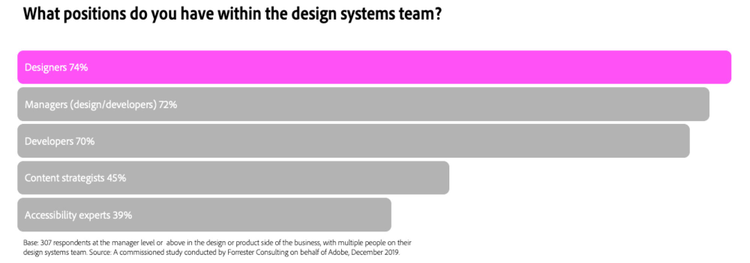Unlocking design’s full business potential

Image source: Adobe Stock/Seahorsevector.
Digital innovation has amplified customers’ expectations. It is no longer enough for businesses to have a responsive website; today, companies must create seamless experiences across websites, mobile apps, and other digital touchpoints. To accomplish this, businesses need an established design team that scales the brand’s design principals and standards across products and experiences.
For many companies, design, however, has not always been a business priority. Customer experience professionals have expressed an immense struggle to educate stakeholders on the value of design. And now that businesses have finally bought in, they are behind. In fact, over a quarter of designers don’t feel like their design practices are competitive.
As design teams run the marathon to success, Adobe wanted to understand what was working and how design teams contribute to success. So, Adobe commissioned an independent study with Forrester to explore exactly that. Below you’ll find a snapshot of what we learned, directly from design leaders themselves.
Firms are investing in design systems
Enterprises are investing in design systems — the principles, templates, components, processes, tools, and people that guide an organization’s design efforts. Businesses recognize the positive impact design systems create within an organization and have poured investments into standing up a team to support their systems. In fact, 86 percent of Forrester’s respondents have an established design systems team with roles for designers (74 percent), developers (72 percent), and managers (70 percent).

Design is a strategic priority
Not only are companies investing in design systems but doing so allows their design teams to impact higher-altitude business decisions. How? By freeing up designer time to solve new challenges instead of working on updates that a design system can address. In fact, 75 percent of respondents said that their design teams impact strategic decisions, such as what unmet customer needs the product should address and how to make more tactical visual and/or user interface (UI) decisions faster.
Investing in design systems is also strategic from a business standpoint. Forrester’s survey found that design systems have improved companies’ speed-to-market, customer satisfaction, and employee productivity.
Design leaders still struggle to keep up with customer expectations
Despite growth in investments, a quarter of respondents surveyed still don’t feel confident in their companies’ design practices. Design teams lack the technology (43 percent) and talent (40 percent) needed to succeed, with 36 percent of leaders admitting that it’s difficult to acquire and keep talent in general. This lack of resources contributes to design leaders feeling like their teams are underperforming; 47 percent of respondents indicated they lack the execution on ideas that would enable them to stand out, and 44 percent said they lack innovative ideas in general.
Solving the customer problem is core to the work of a design team. In the end, the team’s goal is to make the customer’s experience as seamless as possible, which is why it’s troublesome that over a quarter of design professionals struggle to create a consistent customer experience.
Leading design teams have invested in design systems and are more effective because of it
Forrester’s study examined design teams across different maturity levels (methodology in the paper). The study found that companies that have invested more in design systems are in fact more effective. Not only are these companies more efficient and collaborative internally, but they also succeed in creating a more consistent customer experience and have higher customer satisfaction. Forrester found that companies that have invested more in design systems (tools, people, and processes) get products to market faster.
Learn more
If you find this topic interesting, register for the October 1st webinar: Unlocking Design’s Full Business Potential. In this webinar featuring guest speaker Gina Bhawalkar (Principal Analyst, Serving Customer Experience Professionals at Forrester), Gina will present further findings from the research commissioned by Adobe and what it means for design decision makers.
Article written by Vanessa Fabrizio, Market Impact Consultant.
